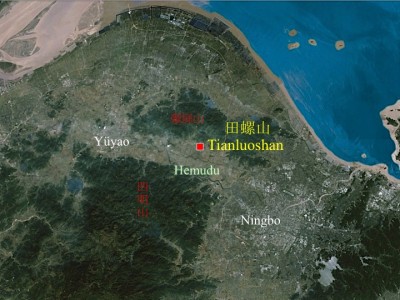Tianluoshan: Tea in the Neolithic Era
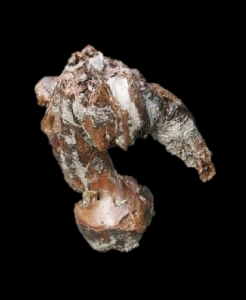 In 2001, the remains of a Neolithic settlement were discovered near the eastern coast of China where archaeologists excavated nearly a dozen roots of the tea plant Camellia sinensis. Each rhizome was found in an extraordinary state of preservation and in a regular pattern of planting. The remarkable find dramatically changed the history of tea by extending the geographical range of primordial Camellia sinensis from the remote fastness of Sichuan in the far west eastward to the marshes and streams of the lower Yangzi and the Zhejiang coast. Moreover, tea culture was no longer confined to the historical period but stretched thousands of years back in time to the fourth millennium B.C. of the late Stone Age.
In 2001, the remains of a Neolithic settlement were discovered near the eastern coast of China where archaeologists excavated nearly a dozen roots of the tea plant Camellia sinensis. Each rhizome was found in an extraordinary state of preservation and in a regular pattern of planting. The remarkable find dramatically changed the history of tea by extending the geographical range of primordial Camellia sinensis from the remote fastness of Sichuan in the far west eastward to the marshes and streams of the lower Yangzi and the Zhejiang coast. Moreover, tea culture was no longer confined to the historical period but stretched thousands of years back in time to the fourth millennium B.C. of the late Stone Age.
The noteworthy discovery was made at the foot of Tianluoshan or Snail Hill at the mouth of a small coastal plain that leads up to Xiang’ao, a hamlet nestled in the foothills of Jade Screen Mountain in the county of Yüyao near the city of Ningbo, Zhejiang. Tianluoshan is a mere seven kilometers northeast across the plain from Mount Siming and the contemporaneous Neolithic site of Hemudu.
The ancient Hemudu people were a matriarchal society of agrarians, cultivators of domesticated rice and crops who raised dogs, pigs, and water buffalo. They hunted deer and fished for carp and grew, gathered, and stored a wide variety of edible plants, including acorn, squash, lotus, water caltrop, and foxnut. The Hemudu employed stone, wood, gourd, and bone tools and made clay pottery tempered with charcoal, wove fibers into cloth, and knotted nets of cord and rope. They carved jade, wood, and ivory into decorations and symbols and painted their hunting bows and serving bowls with colored lacquers. The important Hemudu finds were mirrored at nearby Tianluoshan, a site that yielded the best-preserved remnants of Hemudu culture: building foundations, storage pits, utensils, tools, gardens, and fields, including plantings of tea.
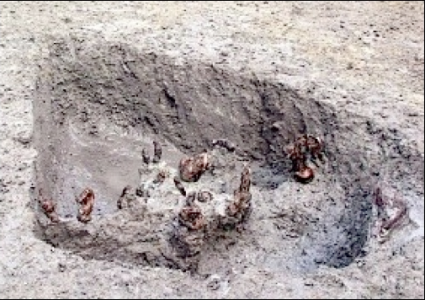 The Tianluoshan tea roots were unearthed during the four months of the first season in early 2004. Found in two locations at a depth of one meter below ground level and covering an area of about ten square meters, the many rhizomes were arranged in rows. Two of the roots displayed a fresh brown color and stood upright as originally planted, their high state of preservation due to unusual soil conditions. In Neolithic times, Tianluoshan was surrounded by marshland, and humans lived in pile-dwellings above sodden earth. Over the millennia, the Ningbo plain experienced floods due to drastic shifts in riverine systems and possible transgressions from the sea. When Tianluoshan was inundated and the settlement abandoned to floodwaters, sediment buried and sealed the site in anaerobic silt that – in concert with a persistent high water table – preserved its artifacts. All the tea roots were uncovered in several shallow pits filled with relatively loose, light-colored soil that contrasted with the surrounding dark, compacted earth. The pits were dug near dwellings within the residential area of the settlement – further evidence that the roots were cultivated.
The Tianluoshan tea roots were unearthed during the four months of the first season in early 2004. Found in two locations at a depth of one meter below ground level and covering an area of about ten square meters, the many rhizomes were arranged in rows. Two of the roots displayed a fresh brown color and stood upright as originally planted, their high state of preservation due to unusual soil conditions. In Neolithic times, Tianluoshan was surrounded by marshland, and humans lived in pile-dwellings above sodden earth. Over the millennia, the Ningbo plain experienced floods due to drastic shifts in riverine systems and possible transgressions from the sea. When Tianluoshan was inundated and the settlement abandoned to floodwaters, sediment buried and sealed the site in anaerobic silt that – in concert with a persistent high water table – preserved its artifacts. All the tea roots were uncovered in several shallow pits filled with relatively loose, light-colored soil that contrasted with the surrounding dark, compacted earth. The pits were dug near dwellings within the residential area of the settlement – further evidence that the roots were cultivated.
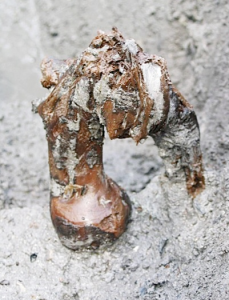 At the time of excavation, the botanical identification of the plant material was undetermined, but later examination tentatively ascertained that the roots belonged to the plant family Theaceae, genus Camellia. Confirmation awaited further testing. In the interim, the rhizomes were stored at the Hemudu Site Museum, immersed in purified water. Despite the lack of positive identification, news of the archaeological discovery of Neolithic tea was announced in September of 2004 at the Eighth International Tea Culture Symposium held at Yan’an, Sichuan.
At the time of excavation, the botanical identification of the plant material was undetermined, but later examination tentatively ascertained that the roots belonged to the plant family Theaceae, genus Camellia. Confirmation awaited further testing. In the interim, the rhizomes were stored at the Hemudu Site Museum, immersed in purified water. Despite the lack of positive identification, news of the archaeological discovery of Neolithic tea was announced in September of 2004 at the Eighth International Tea Culture Symposium held at Yan’an, Sichuan.
In 2008, the Zhejiang Bureau of Cultural Relics and Beijing University invited six Japanese archaeobotanists from Tohaku and Kanazawa universities to assist in testing the roots found at Tianluoshan. Six specimens were examined and consequently identified as rhizomes – below ground as opposed to above ground plant matter – and that the roots belonged to the botanical genus Camellia. The carbon-14 age by accelerator mass spectrometry of one sample dated to 3526- 3366 B.C. with an 87.7 percent probability. Furthermore, the guest researchers reviewed the archaeological evidence of the roots in situ and concurred that the botanicals were deliberately planted and under cultivation. On December 1st of the same year, Reference News, a government daily published by the official Xinhua News Agency, reported that “Chinese and Japanese Experts Discover 6,000 Year Old Tea Site” and observed that “this discovery suggests tea may have been cultivated at an earlier stage” than previously thought.
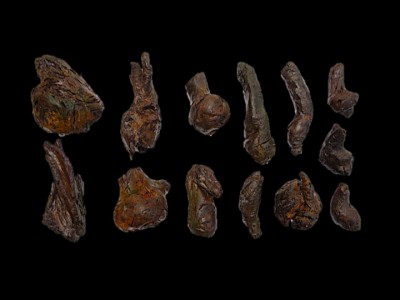 As per the further recommendation of the Japanese scientists, the Tea Research Institute of the Chinese Academy of Agricultural Sciences conducted chemical analysis of the Tianluoshan roots and the purified water in which they were immersed, stored, and preserved. The samples all tested positive for the key ingredient theanine, a rare amino acid found almost exclusively in the plant Camellia sinensis. In tea, theanine biosynthesizes in the rhizome and concentrates there before its metabolic transfer through trunk and branches to leaves. Theanine is the most abundant of the many amino acids found in tea: of the twenty-six amino acids present in tea leaves during the spring flush, theanine constitutes fifty percent of the total; of the twenty-five amino acids in brewed tea, theanine is highest in quantity. The archeological specimens from Tianluoshan presented a potency of theanine that was equivalent to the range of 0.52 to 0.69 percent usually found in live tea roots. As the signature marker for tea, the strong presence of theanine positively confirmed the identification of the Tianluoshan rhizomes as Camellia sinensis.
As per the further recommendation of the Japanese scientists, the Tea Research Institute of the Chinese Academy of Agricultural Sciences conducted chemical analysis of the Tianluoshan roots and the purified water in which they were immersed, stored, and preserved. The samples all tested positive for the key ingredient theanine, a rare amino acid found almost exclusively in the plant Camellia sinensis. In tea, theanine biosynthesizes in the rhizome and concentrates there before its metabolic transfer through trunk and branches to leaves. Theanine is the most abundant of the many amino acids found in tea: of the twenty-six amino acids present in tea leaves during the spring flush, theanine constitutes fifty percent of the total; of the twenty-five amino acids in brewed tea, theanine is highest in quantity. The archeological specimens from Tianluoshan presented a potency of theanine that was equivalent to the range of 0.52 to 0.69 percent usually found in live tea roots. As the signature marker for tea, the strong presence of theanine positively confirmed the identification of the Tianluoshan rhizomes as Camellia sinensis.
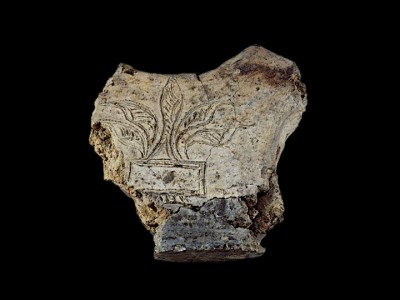 At Hemudu and Tianluoshan, humans exploited the natural resources of their environs, not only domesticating animals to their needs but also cultivating plants and herbs of many kinds. During the late Stone Age of about 5500 years ago, the region of the lower Yangzi benefited from the Holocene climate optimum. Warm and humid, the weather fostered a subtropical ecological system that sustained a relatively great biological diversity, including the cultivation of the broad-leaf evergreen Camellia sinensis. When the climate later dried and cooled, tea was no longer a viable crop and disappeared as a botanical from the eastern seaboard. Millennia would pass before tea was reintroduced to the region.
At Hemudu and Tianluoshan, humans exploited the natural resources of their environs, not only domesticating animals to their needs but also cultivating plants and herbs of many kinds. During the late Stone Age of about 5500 years ago, the region of the lower Yangzi benefited from the Holocene climate optimum. Warm and humid, the weather fostered a subtropical ecological system that sustained a relatively great biological diversity, including the cultivation of the broad-leaf evergreen Camellia sinensis. When the climate later dried and cooled, tea was no longer a viable crop and disappeared as a botanical from the eastern seaboard. Millennia would pass before tea was reintroduced to the region.
Historically, the archaeological finds at Tianluoshan testify to the Neolithic cultivation of Camellia sinensis in parts hitherto unknown, deepening its antiquity and broadening its geography while giving credence to an enduring tea culture aptly illustrated by the ancient myth of Shen Nong the Divine Cultivator and the discovery of tea.
Dedication
Many thanks to Dr. Ling-yu Hung, Assistant Professor in the Department of Anthropology, Indiana University, Bloomington, and thanks to Dr. Tong Zhengxiang, Secretary of the China International Tea Culture Institute, Tianmen, Hubei.
Figures
1.
Rhizome, 4th millennium B.C.
Camellia sinensis
Neolithic: Hemudu Culture
Unearthed from the Tianluoshan site in 2004
Tianluoshan Archaeological Site Museum
Yüyao, Zhejiang
2.
Map of Tianluoshan and Region
3.
Excavation pit with rhizomes in situ, 4th millennium B.C.
Camellia sinensis
Neolithic: Hemudu Culture
Unearthed from the Tianluoshan site in 2004
Tianluoshan Archaeological Site Museum
Yüyao, Zhejiang
4.
Rhizome in situ, 4th millennium B.C.
Camellia sinensis
Neolithic: Hemudu Culture
Unearthed from the Tianluoshan site in 2004
Tianluoshan Archaeological Site Museum
Yüyao, Zhejiang
5.
Preserved rhizomes, 4th millennium B.C.
Camellia sinensis
Neolithic: Hemudu Culture
Unearthed from the Tianluoshan site in 2004
Tianluoshan Archaeological Site Museum
Yüyao, Zhejiang
6.
Potsherd with plant design
Earthenware pottery
Neolithic: Hemudu Culture
Unearthed from the Hemudu site in 1977
Hemudu Site Museum
Yüyao, Zhejiang
Selected References
Hemudu-Xishiqishidai yizhi kaogu fajüe baogao 河姆渡– 新石器时代遗址考古发掘报告 (Hemudu: Excavation Report of a Neolithic Site). Zhejiang sheng wenwu kaogu yanjiu suo 浙江省文物考古研究所 (Zhejiang Cultural Relics Archaeological Research Institute), ed. Beijing: Wenwu 文物, 2003.
Hemudu yizhi diyiqi fajüe baogao 河姆渡遗址第一期发掘报告 (Report of the First Excavation at the Hemudu Site), Zhejiang sheng wenwu guanli weiyüanhui and 浙江省文物管理委員會 (Zhejiang Cultural Relics Management Committee) and Zhejiang sheng bowuguan 浙江省博物館 (Zhejiang Museum), eds., Kaogu Xuebao 考古學報 (Journal of Archaeology, 1978), no. 1, pp. 39–94.
Lu, Tracey L.-D. “Mid-Holocene Climate and Cultural Dynamics in Eastern Central China.” Climate Change and Cultural Dynamics: A Global Perspective on Mid-Holocene Transitions. David G. Anderson et al., eds., pp. 297-330. London: Academic Press, 2011.
Nakamura Shinichi 中村慎一. “Archeobotanical Study of Neolithic Sites in China Sheds Light on the Origins of Lacquer and Tea Use.” Kakenhi News: Grants in Aid for Scientific Research of Japan (2009), vol. 1, p. 4.
Nakamura Shinichi 中村慎一, ed. Sekkoushou Yoyou Denrasan iseki no gaku jutsu teki sougou kenkyuu 浙江省余姚田螺山遺跡の学際的総合研究 (Interdisciplinary Research of the Tianluoshan Site at Yüyao, Zhejiang). Kanazawa: Tenchu Shobundo 田中昭文堂印刷, 2010.
Qin Ling 秦岭, Fu Daolian 傅稻鐮 (Dorian Q. Fuller), & Zhang Hai 張海. “Modelling Wild Food Resource Catchments Amongst Early Farmers: Case Studies from the Lower Yangtze and Central China.” Disiji yanjiu 第四纪研究 (Quaternary Sciences, March, 2010), vol. 30, no. 2, pp. 245-261, esp. 248.
Sun Guoping. “Recent Research on the Hemudu Culture and the Tianluoshan Site.” A Companion to Chinese Archaeology. Anne P. Underhill, ed. pp. 555-573, esp. 567-572. Chichester: Wiley-Blackwell, 2013.
Sun Guoping 孫國平and Huang Weijin 黄渭金. “Zhejiang Yüyao Tianluoshan yizhi chuxian duanni 浙江余姚田螺山遗址初现端倪 (The Emergence of the Tianluoshan Site, Yuyao, Zhejiang).” Zhongguo wenwu bao 中國文物報 (Journal of Chinese Cultural Relics, August, 2004), vol. 6, no. 1.
Sun Guoping 孫國平, Huang Weijin 黃渭金, Zheng Yunfei 鄭雲飛, et al. “Tianluoshan yizhi 2004 kaogu fajüe jianbao 余姚田螺山遺址2004年考古發掘簡報 (Brief Report of the 2004 Excavation of a Neolithic Site at Tianluoshan in Yüyao, Zhejiang).” Wenwu文物 (Cultural Relics, 2007), no. 11, pp. 4-24.
Tea: Bioactivity and Therapeutic Potential. Zhen, Yong-su, ed., pp. 5, 6, and 64-65. London: Taylor and Francis, 2002.
Tianluoshan yizhi Hemudu wenhua xin shichuang 田螺山遺址河姆渡文化新視窗 (Tianluoshan: A New Window on the Hemudu Culture). Tianluoshan bianweihui 田螺山編委會 (Tianluoshan Editorial Group), ed. Hangzhou: Xiling, 2009.
Tianluoshan yizhi ziran yicun zonghe yanjiu 田螺山遗址自然遗存综合研究 (Integrated Studies on the Natural Remains from Tianluoshan). Beijing daxüe Zhongguo kaogu yanjiu zhongxin. 北京大學中國考古學研究中心 and Zhejiang sheng wenwu kao gu yanjiu suo浙江省文物考古研究所, eds. Beijing: Wenwu, 2011.
You Xiuling 游修齡. “Dui Hemudu disi wenhua ceng chutu daoku he gusi di jidian kanfa 對河姆渡第四文化層出土稻谷和骨耜的幾點看法 (A Few Opinions about the Rice Remains and Bone Plows from Layer 4 at the Hemudu Site).” Wenwu 文物 (Cultural Relics, 1976), no. 8, pp. 20–23.
Yingxiang Zhongguo cha wenhuashi de Pubu Xianming 影響中國茶文化史的瀑布仙茗 (Pubu Xianming: The Tea and Its Influence on Chinese Tea Culture). Yüyaoshi chawenhua cujinhui 余姚市茶文化促進會編 (Yüyao Tea Culture Promotion Association), ed., Beijing: Zhongguo wen shi chu ban she 中國文史出版社, 2011.
Zhang Liang, et al. “L-Theanine from Green Tea: Transport and Effects on Health.” Tea in Health and Disease Prevention. Victor R. Preedy, ed. pp. 425-435. Elsevier, 2013.
Zhejiang Hemudu yizhi dierqi fajüe di zhuyao shouhuo 浙江河姆渡遗址第二期发掘的主要收获 (Main Results of the Second Excavation at the Hemudu Site). Hemudu kaogu dui 河姆渡考古队 (Hemudu Archaeological Team), eds. Wenwu 文物 (Cultural Relics, 1980), no. 5, pp. 1–15.
“Zhejiang Yüyao Tianluoshan yizhi 浙江余姚田螺山遗址 (The Tianluoshan Site at Yüyao, Zhejiang.” Zhongguo kaogu 中國考古 (Chinese Archaeology, Institute of Archaeology, Chinese Academy of Sciences). (March 18, 2013 http://www.kaogu.cn/cn/detail.asp?ProductID=16280 accessed May 19, 2013).

